Why water is not collected in the toilet bowl - a solution
When arranging the toilet, a lot of attention is given to the toilet, because it is the main element in the room. But even under the condition that the work on its installation and connection was performed perfectly, it is not uncommon for the toilet to be operated with problems. Especially often there are situations when the water in the tank is too slowly (or not at all), this failure is trivial, but can cause a lot of trouble.
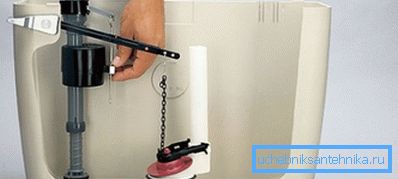
Device and principle of operation
In order to figure out what to do if the toilet does not get water, you first need to understand the structure and operation of the cistern. Only after that you can proceed to the practical part and engage in repair.
This component of the sewer system can be placed at some distance from the toilet bowl (vertically), thanks to which the flow with great force washes the bowl of the toilet bowl and removes human waste products. In this case, the tank is connected to the toilet using a pipeline.
Recently, models have become popular, forming a single whole with the toilet, sometimes they even disguise themselves behind decorative partitions. But the most important thing is that regardless of the location, the principle of operation and the device of the cistern remains the same.
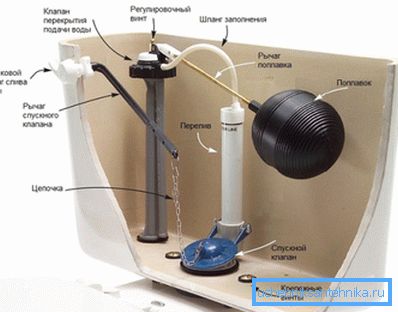
The design of such a device should provide:
- a set of water up to a certain level, namely the breakdown of this mechanism often becomes the reason that water is not drawn into the tank;
- the possibility of full or partial release of water into the toilet.
The water set is organized as follows:
- in order that during descent its giving was resumed, the float fixed on the end of the lever is used;
- when lowering the float decreases and opens the channel through which water flows;
- as soon as the fluid level is restored, the raised float blocks its flow.
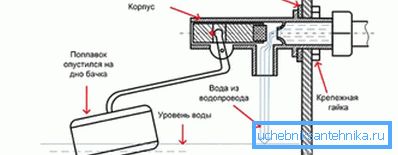
Note! There are models with a lower flow, in this case, the noise when filling is almost not audible, but the design is somewhat more complicated, and the price is higher.

In the obsolete models for descent, a similar principle was used - the drain hole was closed with a small valve or a rubber bulb. The lever that extends beyond the case of the case is connected to it with a chain, when you press it, the drain hole opens and a flush occurs.

Malfunctions with this component can cause the water to be drawn into the toilet bowl for a long time — some of it will simply go through the tightly closed drain hole. Further in the article a simple way to eliminate this malfunction is proposed.
From the point of view of repair, such a design is just perfect - a minimum of moving parts, and simplicity rolls over. But in modern toilet bowls, a different type of stop valves is used, which allows you to adjust the flush force (the volume of water produced). In this case, a button consisting of 2 parts is used for descent, each of its segments is responsible for washing off different forces.
Note! To flush in the modern toilet, simply press the button, keep the lever all the time, as it was necessary in the old sanitary ware, there is no need.
Possible defects and solutions
Often there are problems with the collection or discharge of water, for example, the toilet cistern does not collect water or does not collect it as quickly as it should. In any case, have a little digging in the "giblets" of the cistern.
Water supply problems
Such defects can lead to the fact that the water absolutely does not fall into the tank or you have to wait too long until it is full.
There may be several reasons for this:
- wrong float position - is the cause of overflow or vice versa of too little water. To fix the malfunction with your own hands, it's enough just to slightly bend the wire and give the float the required position;
- the float may twist a little, in this case it is enough just to move it with your hand;
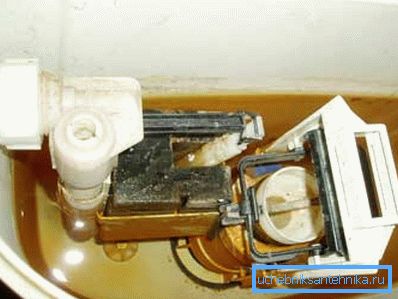
Note! In modern toilet bowls, you can adjust the position of the float just by tightening the screw.
- if water is slowly collected in the toilet bowl (or not at all), then you should check if the water supply hole is not contaminated. To do this, just gently remove the float, the membrane, remove dirt and collect the float knot back;
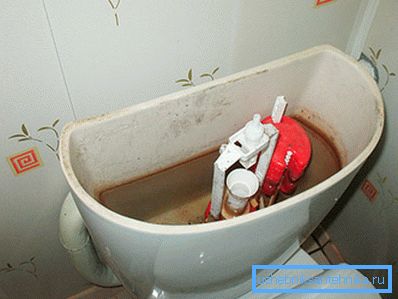
- water flows continuously - in this case only the replacement of the float assembly will help. Most likely, the lever, on which the float is fixed, just broke; in this case, after filling, the water supply hole does not overlap.
Note! Not always the problem is in the installed fixture. For example, the reason that the water in the toilet bowl is poorly collected water may be clogged or bend the pipe in the area outside the tank.
Problems with the drain
Malfunctions can occur not only with the water supply, but also directly with the drain.
The most common problems such as:
- the constant murmur of flowing water indicates that the drain valve is faulty and does not provide 100% overlap of the drain hole, as a result, there is not enough water in the toilet for flushing the waste products of a person. In order to eliminate the malfunction, you just need to check the rubber gasket - it could lose elasticity, also solid particles could fall under it. In neglected cases, the replacement of the gum will help, if the cause of the leakage is garbage, then simple cleaning will be enough;

Note! If the simplest lever design is used, then it is sufficient to simply purchase a rubber bulb that covers the drain. If a more modern device is used, it may be necessary to purchase the entire internal reinforcement of the tank in the complex.
- the reason for the constant murmur of water in the toilet can be incorrect adjustment of the float. In this case, the tank is full, and the excess water is simply drained into the sewer system. Instructions to eliminate this drawback is to adjust the position of the float.
In conclusion
The device of a cistern, even the most modern, is not particularly complex, so that the removal of most of the faults can be done independently. This will not only guarantee the correct operation of the tank, but also save the family budget from unplanned expenses.
The video in this article shows a fundamental solution to the problem - the complete replacement of the tank fittings.